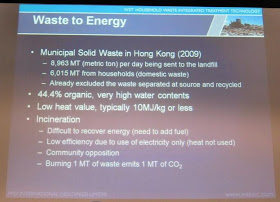In the beginning, Vincent briefed the current approach of renewable energy which tried to implement in Hong Kong. The definition of Renewable Energy was introduced as “Energy sources that are naturally replenishing but flow limited. They are virtually inexhaustible in duration but limited in the amount of energy that is available per unit of time.” Renewable energy sources include: biomass, hydro, geothermal, solar, wind, ocean thermal, wave action and tidal action.

Wind EnergyThe First wind turbine in Hong Kong has started operation in XX Island since February 2006 from HEC. But the efficiency was too low and cost was too high to achieve the target that 1% of renewable energy generation in HEC. The data from Hong Kong Observatory showed that there were only 5 out of 16 automatic weather stations those average annual mean wind speed about 5.0 m/s. Moreover, it caused noise problem because of closing to housing area.

Solar EnergyEMSD has study on the potential application of solar panel in Hong Kong since December 2002. However, the cost of electricity was too high (HK$3.4 / kWh – 4% discount, 25 years).

Waste to EnergyThen Vincent proposed “Waste to Energy”. In 2009, there was 8963 metric ton (MT) waste per day being sent to the landfill. 44.4% of waste was organic with very high water contents. It is the difficulties in treating household waste. Therefore, incineration was found not efficiency.

The key solutions of waste problem are to:
i) Take out all the recyclable materials from the waste, leaving those with no or low value inert materials as the final waste for landfill;
ii) Separate the recyclable materials by type to facilitate the downstream recycling processes.

The speaker introduced the mechanism of WST Sorting System and how it can turn waste to resources as follows.
i) Organic Matter and Sludge (biogas process using anaerobic digestion)
ii) Non-organic Fraction (Recycling ferrous metals and brick production for inert materials)
iii) Plastic Fraction to be converted into fuel oil or plastic pellets
iv) Combustibles Fraction (about 28.8% of domestic waste was combustible materials such as paper, textile, wood, etc.)





沒有留言:
發佈留言